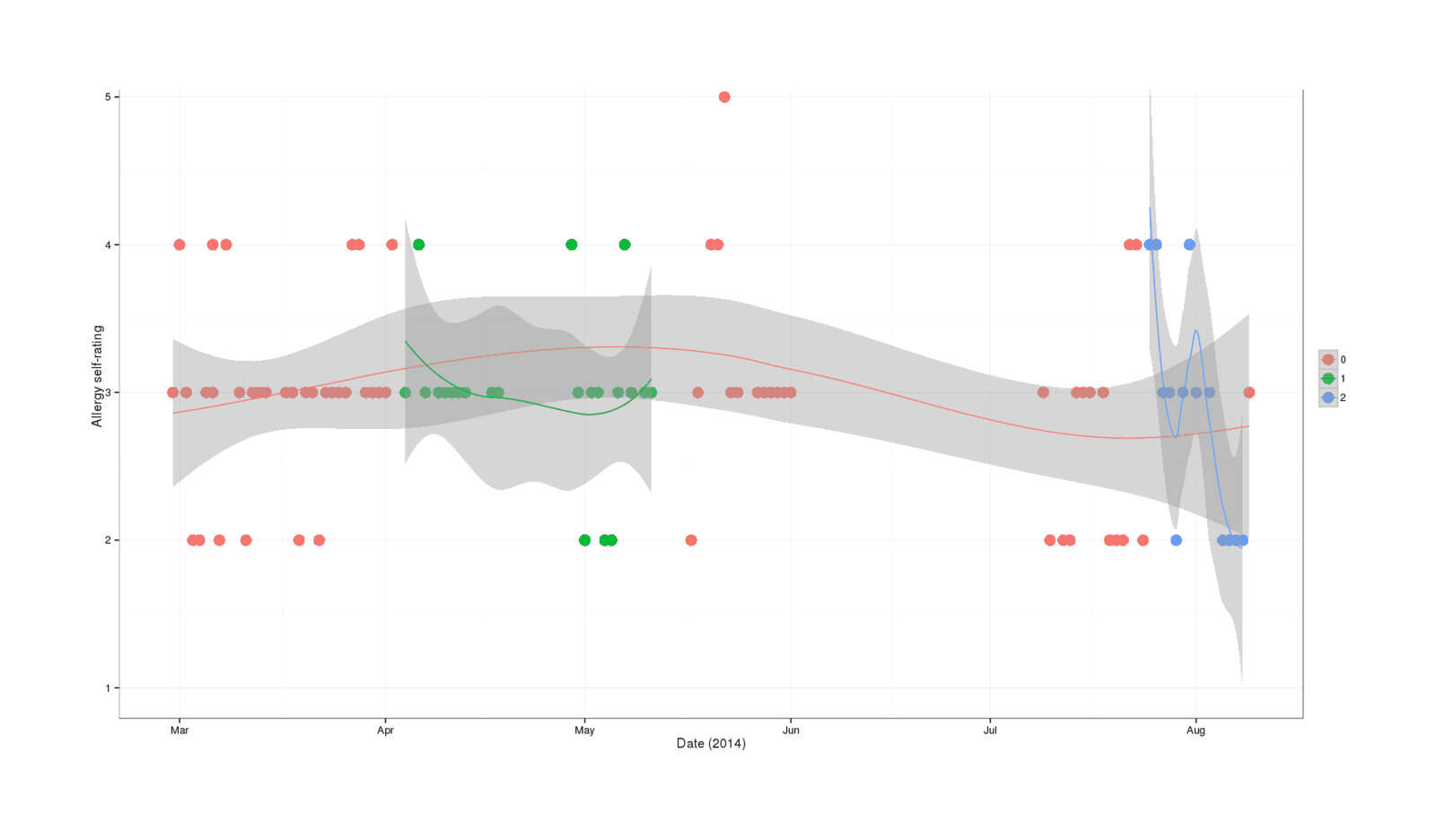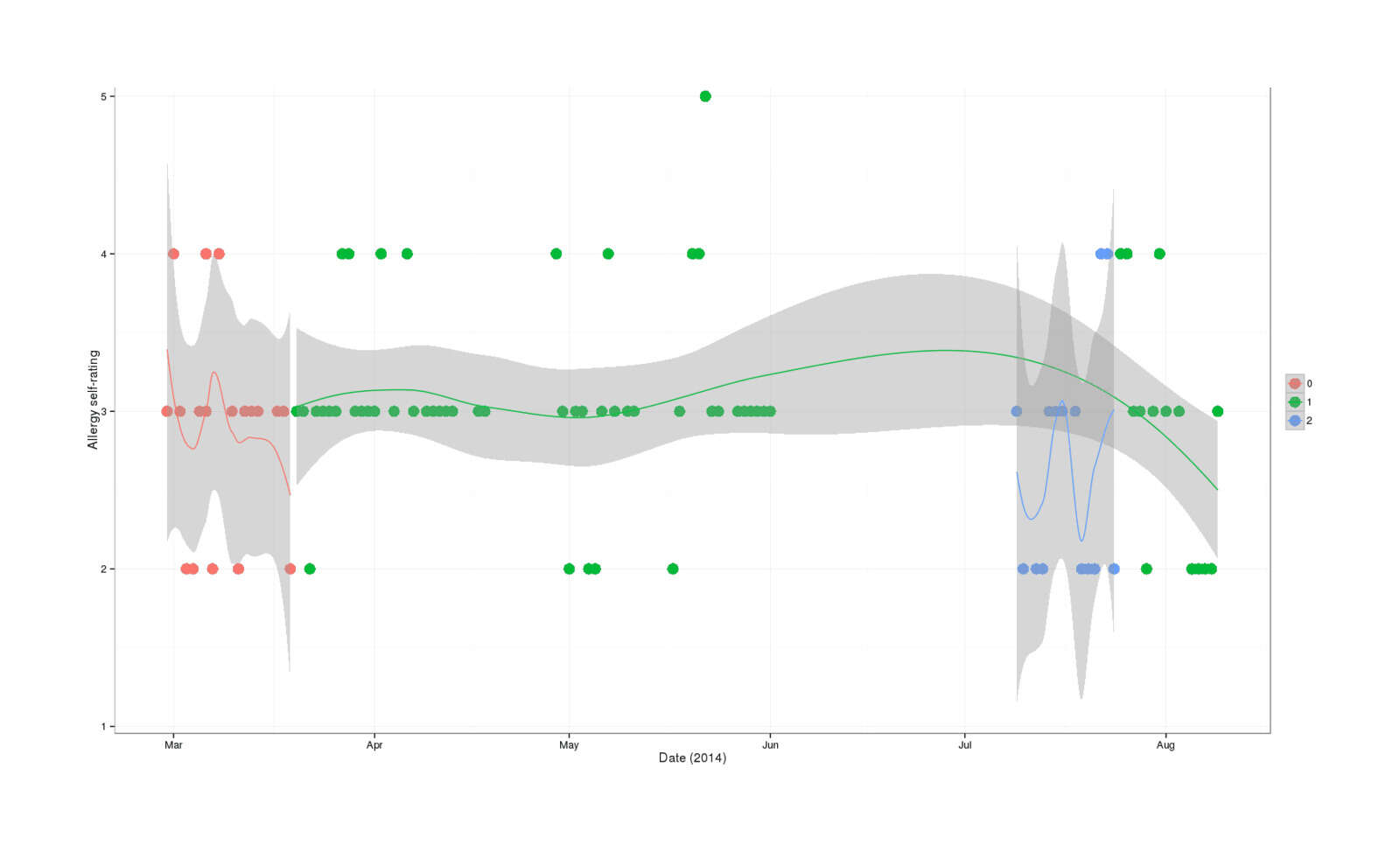2014 Spirulina randomized self-experiment
Spirulina users’ randomized trial on self-rated allergy symptoms: null result.
The supplement Spirulina has been suggested to help allergy symptoms. A randomized self-experiment is run by sceaduwe April—August 201411ya. Analysis suggests no effect of the spirulina.
Spirulina is a photosynthetic algae which can be grown for food (dried spirulina is high in protein); it is also used by some as a supplement due to various other substances in it. There is a little human research ( et al 2005, et al 2008) suggesting it may help allergy problems like hay fever, but nothing conclusive.
Background
sceaduwe suffers from allergies and post-nasal drip each year during pollen season, so he became interested in whether spirulina might help and reduce the need for his anti-allergy medication (cetirizine hydrochloride/“Zyrtec”), but he didn’t want to waste money on a dodgy supplement. I gave him advice on designing & running a self-experiment testing spirulina, and offered to analyze the data should he ever finish the experiment.
Experiment
He proposed doing a repeated-measures n = 1 blind randomized self-experiment during spring/summer 201411ya, in which he would rate post-nasal drip each day on a scale 1-5 where 1=completely-clear and 5=can’t-breath. The spirulina tablet would be put into pills with the placebo pills being filled with creatine monohydrate (safe, cheap, similar weight, possibly helpful for other things), for doses roughly around 0.8g of creatine / 0.7g of spirulina; these pills could be doubled for some blocks if he chose. The cited experiments used long blocks, so he’d randomize multiple weeks in pairs of blocks 50:50, and the blinding/randomization would be done with my usual trick of two identical but marked containers. Data collection was limited by the seasonality of allergies: once the worst days pass, no more data can be collected until the next year.
As part of the baseline, he took creatine for some days before beginning the spirulina experiment proper from 2014-04-04 to 2014-08-08, with a long lapse in June/July when he became distracted by other matters By 8 April, it had become clear the blinding had failed (“spirulina burps”), so it was just randomized. And at the end, sceaduwe believed the spirulina was ineffective and turned his data over to me for analysis.
Data
There were several variables to code up:
-
the post-nasal drip / allergy self-rating (1-5); the outcome variable
-
whether it was pollen season (April to May, roughly)
-
spirulina dose
-
whether he used anti-allergy medicine on the worst days
-
creatine dose
-
where he was living
sceaduwe moved apartments in August 201411ya, and I thought this covariate was worth inclusion as different rooms/locations may aggravate allergies differently.
Due to the lapse and including the baseline, that yields 95 days of data.
Descriptive:
spirulina <- read.csv("https://gwern.net/doc/nootropic/quantified-self/2014-sceaduwe-spirulina.csv",
colClasses=c("Date", "logical", "integer", "integer", "logical", "logical", "integer", "factor"))
summary(spirulina)
## Date Pollen.season Allergy.rating Spirulina Spirulina.random
## Min. :2014-02-28 Mode :logical Min. :2.00000 Min. :0.000000 Mode :logical
## 1st Qu.:2014-03-25 FALSE:79 1st Qu.:3.00000 1st Qu.:0.000000 FALSE:33
## Median :2014-05-04 TRUE :16 Median :3.00000 Median :0.000000 TRUE :62
## Mean :2014-05-12 NA's :0 Mean :2.95789 Mean :0.505263 NA's :0
## 3rd Qu.:2014-07-13 3rd Qu.:3.00000 3rd Qu.:1.000000
## Max. :2014-08-09 Max. :5.00000 Max. :2.000000
## Allergy.medicine Creatine Location
## Mode :logical Min. :0.000000 A:90
## FALSE:86 1st Qu.:1.000000 B: 5
## TRUE :9 Median :1.000000
## NA's :0 Mean :0.957895
## 3rd Qu.:1.000000
## Max. :2.000000
library(ggplot2)
qplot(Date, Allergy.rating, color=as.ordered(Spirulina), data=spirulina) +
theme_bw() +
xlab("Date (2014)") + ylab("Allergy self-rating") +
theme(legend.title=element_blank()) +
geom_point(size=I(5)) +
stat_smooth()
Allergy self-rating over time, colored by spirulina dose (0, 1, 2 pills), and smoothed
Analysis
At a first stab, I load up the data and regress on #2-6:
l <- lm(Allergy.rating ~ Pollen.season + Creatine + Location + Allergy.medicine + Spirulina,
data=spirulina[spirulina$Spirulina.random,])
summary(l)
##
## ...Coefficients:
## Estimate Std. Error t value Pr(>|t|)
## (Intercept) 3.7497249 0.4032818 9.29803 5.9712e-13
## Pollen.seasonTRUE 0.0995488 0.2732337 0.36434 0.7169796
## Creatine -0.5534339 0.2489801 -2.22280 0.0302834
## Location B -1.1608519 0.3648258 -3.18193 0.0023872
## Allergy.medicineTRUE -0.5023112 0.3210568 -1.56456 0.1233211
## Spirulina -0.01277196 0.1390217 -0.12746 0.8990337
##
## Residual standard error: 0.631029 on 56 degrees of freedom
## Multiple R-squared: 0.250248, Adjusted R-squared: 0.183305
## F-statistic: 3.73827 on 5 and 56 DF, p-value: 0.00544645
library(MASS)
pl <- polr(as.ordered(Allergy.rating) ~ Pollen.season + Creatine + Location + Allergy.medicine + Spirulina,
data=spirulina[spirulina$Spirulina.random,])
summary(pl)
## ...Coefficients:
## Value Std. Error t value
## Pollen.seasonTRUE 0.5572250 0.865166 0.6440669
## Creatine -1.8439587 0.846798 -2.1775671
## Location B -16.4522527 634.533164 -0.0259281
## Allergy.medicineTRUE -1.8680170 1.078616 -1.7318653
## Spirulina 0.0466616 0.445739 0.1046836
##
## Intercepts:
## Value Std. Error t value
## 2|3 -3.910809 1.418710 -2.756594
## 3|4 -0.672510 1.281926 -0.524609
## 4|5 1.977223 1.601942 1.234267
##
## Residual Deviance: 106.639735
## AIC: 122.639735The immediate answer to the primary causal question is clear: no, the spirulina has no apparent effect either good or bad.
The other variables are interesting, though: of course the allergy medicine has an effect (presumably that was proven by the clinical trials that got it approved), but what’s creatine doing with p < 0.03 and Location at p < 0.002?
Looking at Location closer, it only changes right before the data series ends in August, and August should be well past the pollen danger season, so it may be a confound with allergies over the seasons, which we’d expect to look something like an inverted U-curve peaking in spring/summer. This suggests adding a quadratic term to the regression model, something like I(as.integer(Date)^2), but then a step() (which penalizes complexity) prefers using the Location variable to the quadratic:
l2 <- lm(Allergy.rating ~ Date + I(as.integer(Date)^2) + Pollen.season + Creatine + Allergy.medicine + Spirulina + Location,
data=spirulina[spirulina$Spirulina.random,])
summary(l2)
## ...Coefficients:
## Estimate Std. Error t value Pr(>|t|)
## (Intercept) 2.65011e+04 4.87941e+04 0.54312 0.5892816
## Date -3.26909e+00 6.01720e+00 -0.54329 0.5891648
## I(as.integer(Date)^2) 1.00832e-04 1.85509e-04 0.54354 0.5889936
## Pollen.seasonTRUE 2.12637e-01 3.34582e-01 0.63553 0.5277659
## Creatine -8.82748e-01 5.25005e-01 -1.68141 0.0984595
## Allergy.medicineTRUE -4.49432e-01 3.33177e-01 -1.34893 0.1829898
## Spirulina -2.31188e-01 3.59458e-01 -0.64316 0.5228438
## Location B -1.34235e+00 4.47436e-01 -3.00010 0.0040776
##
## Residual standard error: 0.639404 on 54 degrees of freedom
## Multiple R-squared: 0.257707, Adjusted R-squared: 0.161484
## F-statistic: 2.67822 on 7 and 54 DF, p-value: 0.0186685
step(l2)
## ...Call:
## lm(formula = Allergy.rating ~ Creatine + Allergy.medicine + Location,
## data = spirulina[spirulina$Spirulina.random, ])
##
## Residuals:
## Min 1Q Median 3Q Max
## -1.200000 -0.200000 -0.200000 0.323413 1.800000
##
## Coefficients:
## Estimate Std. Error t value Pr(>|t|)
## (Intercept) 3.757143 0.267633 14.03840 < 2.22e-16
## Creatine -0.557143 0.196389 -2.83693 0.0062644
## Allergy.medicineTRUE -0.422222 0.232107 -1.81908 0.0740620
## Location B -1.200000 0.327782 -3.66096 0.0005447
##
## Residual standard error: 0.621037 on 58 degrees of freedom
## Multiple R-squared: 0.247869, Adjusted R-squared: 0.208965
## F-statistic: 6.3714 on 3 and 58 DF, p-value: 0.00083053My guess here is that there’s not enough data, particularly in the June/July gap, to justify the curve when location A vs location B happens to overfit the latter points so well, but I still believe this Location B estimate is being driven by seasons.
What about creatine, is that seasonal too? sceaduwe didn’t do creatine initially, but he started creatine before the pollen season and never stopped in the data, so it shouldn’t be driven by the same end-of-allergy-season effect. A plot:
qplot(Date, Allergy.rating, color=as.ordered(Creatine), data=spirulina) +
theme_bw() +
xlab("Date (2014)") + ylab("Allergy self-rating") +
theme(legend.title=element_blank()) +
geom_point(size=I(5)) +
stat_smooth()
Allergy self-rating over time, colored by creatine dose (0, 1, 2 pills), and smoothed
The creatine estimate seems to be driven by the period with 2 pills. I don’t know of any prior reason to expect creatine to have any effect on allergies or post-nasal drip, so I wonder if this turned out to be a subtler form of the seasonal effect due to the extra weighting of the double-dose in the regression?
If I expand the dataset to include the baseline as well, and I look at creatine as a factor, the effect also seems to disappear:
l3 <- lm(Allergy.rating ~ Date + I(as.integer(Date)^2) + Pollen.season + as.factor(Creatine) + Allergy.medicine + Spirulina + Location,
data=spirulina)
summary(l3)
## ...Coefficients:
## Estimate Std. Error t value Pr(>|t|)
## (Intercept) 9.07174e+03 1.64581e+04 0.55120 0.5829234
## Date -1.12123e+00 2.03062e+00 -0.55216 0.5822707
## I(as.integer(Date)^2) 3.46557e-05 6.26343e-05 0.55330 0.5814923
## Pollen.seasonTRUE 1.77142e-01 2.93014e-01 0.60455 0.5470693
## as.factor(Creatine)1 3.44745e-01 3.10455e-01 1.11045 0.2699001
## as.factor(Creatine)2 -4.80779e-01 4.20889e-01 -1.14229 0.2565024
## Allergy.medicineTRUE -4.44689e-01 3.22589e-01 -1.37850 0.1716244
## Spirulina -1.65976e-01 1.55833e-01 -1.06509 0.2898163
## Location B -1.15120e+00 3.89378e-01 -2.95650 0.0040155
summary(step(l3))
## ...Coefficients:
## Estimate Std. Error t value Pr(>|t|)
## (Intercept) 2.888889 0.146343 19.74048 < 2.22e-16
## as.factor(Creatine)1 0.294785 0.171125 1.72263 0.0883899
## as.factor(Creatine)2 -0.246032 0.221250 -1.11201 0.2690973
## Allergy.medicineTRUE -0.405896 0.225167 -1.80265 0.0747911
## Location B -0.983673 0.291490 -3.37464 0.0010922
##
## Residual standard error: 0.620883 on 90 degrees of freedom
## Multiple R-squared: 0.170613, Adjusted R-squared: 0.133752
## F-statistic: 4.62848 on 4 and 90 DF, p-value: 0.00191632If creatine were helping with allergies, one would expect the effect to be at least monotonic, whatever the details of the dose-response curve; but instead we see that 1 pill of creatine correlates with increases in allergies and 2 pills with decrease! So my best guess is that this is spurious too like the Location estimate.
Improvements
If one were trying to run such an experiment, there seem like some ways to improve on this:
-
fix the blinding somehow; perhaps add some strong-tasting ingredient to the capsules?
-
more systematic data; the gap in June/July hampers any attempt to fit a curve to allergies
-
find some way to predict how bad allergies will be on each day: there must be local weather data on pollen count, or maybe particulate count, or failing that, perhaps some small affordable device for measuring air quality.
Is it affected by other things like humidity or temperature? That would be good to include.
-
more directly measure allergies: perhaps quantify it somehow like number of sneezes or kleenexes used? Since allergies are related to histamines, perhaps some chemical level could be measured in saliva? Or one could go indirect: bad allergies might interfere with thinking and so a battery of cognitive tests could expose hidden changes.
Conclusion
Spirulina did not cause a large decrease in allergy symptoms, although this result is weakened by relatively small sample size & apparent temporal/seasonal changes. (These issues could be improved in future experiments by more systematic data collection and longer self-experiments.) Two other variables are interestingly correlated with decreases, but on closer investigation, both seem like they may be proxying for seasonal effects and unlikely to be causing decreases.
I would not suggest sceaduwe supplement spirulina unless he has some other reason to use it.